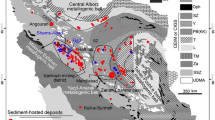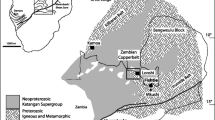Abstract
The Guelb Moghrein Fe oxide–Cu–Au–Co deposit, with a total resource of 23.6 Mt at 1.88% Cu, 1.41 g/t Au, and 143 g/t Co, is hosted by an extensive metacarbonate body. However, it is restricted to up to 30-m wide tabular breccia zones developed parallel to discrete shear zones that transect the host metacarbonates. The Fe–Mg clinoamphibole–chlorite schists represent up to 1-m thick interlayer metasediments and localized viscous shearing in these shear zones. Siderite of the metacarbonate body was deformed into a breccia and was replaced by an ore and alteration assemblage comprised of Fe–Mg clinoamphibole, magnetite, pyrrhotite, chalcopyrite, graphite, Fe–Co–Ni arsenides, arsenopyrite, cobaltite, uraninite, and Bi–Au–Ag–Te minerals. In contact with wall rock amphibolites, the metacarbonate body is enveloped by an alteration halo up to 40 m wide, consisting of biotite, actinolite, grunerite, chlorite, calcite, albite, and quartz. The Guelb Moghrein ore body is structurally controlled by shear zones that developed in the footwall of a regional thrust zone. This thrust separates greenschist facies quartz–sericite schists and biotite–garnet–quartz schists of the Sainte Barbe volcanic unit in the hanging wall from amphibolite facies metavolcanic rocks, metacarbonates, and the Guelb Moghrein ore body of the Akjoujt metabasalt unit in the footwall. Peak temperatures of the latter unit are estimated by hornblende–plagioclase thermometry at 580±40°C. Thrusting was retrograde for the Akjoujt metabasalt unit, but prograde for the Sainte Barbe volcanic unit at P–T conditions of about 410±30°C and 2–3 kbar (garnet–biotite thermometry). Structural and petrological evidences suggest that the ore fluids migrated along the shear zones and reacted with the siderite in the metacarbonate. This evolution and the setting of Guelb Moghrein in the fold-and-thrust belt of the Pan-African to Variscan Mauritanides (Mauritania, West Africa) resemble Proterozoic Fe oxide–Cu–Au–Co deposits such as examples from the Tennant Creek and Mount Isa Inliers, Australia.








Similar content being viewed by others
References
Ba Gatta A (1982) Contribution à l’étude géologique et minéralogique du gisement d’Akjoujt, Mauritanie. PhD Thesis, Université Orléans, Orléans
Bhattacharya A, Mohanty L, Maji A, Sen SK, Raith M (1992) Non-ideal mixing in the phlogopite-annite binary: constraints from experimental data on Fe–Mg partitioning and a reformulation of the biotite–garnet geothermometer. Contrib Mineral Petrol 11:87–93
Caine J, Evans JP, Forster CB (1996) Fault zone architecture and permeability structure. Geology 26:1025–1028
Dallmeyer RD, Lécorché JP (1989) 40Ar/39Ar polyorogenic mineral age record within the central Mauritanide orogen, West Africa. Geol Soc Amer Bull 101:55–70
Dasgupta S, Sengupta P, Guha D, Fukuoka M (1991) A refined garnet–biotite Fe–Mg exchange geothermometer and its application in amphibolites and granulites. Contrib Mineral Petrol 109:130–137
Deer WA, Howie RA, Zussman J (1992) An introduction to rock-forming minerals, 2nd edn. Longman Group, Harlow, UK, p 696
Droop GTR (1987) A general equation for estimating Fe3+ concentrations in ferromagnesian silicates and oxides from microprobe analyses, using stoichiometric criteria. Mineral Mag 51:431–435
Ellis DJ, Hiroi Y (1997) Secondary siderite–oxide–sulphide and carbonate–andalusite assemblages in cordierite granulites from Sri Lanka: post-granulite facies fluid evolution during uplift. Contrib Mineral Petrol 127:315–335
Evans JP, Forster CB, Goddard JV (1997) Permeability of fault-related rocks, and implications for hydraulic structure of fault zones. J Struct Geol 19:1393–1404
Hitzman MW, Oreskes N, Einaudi MT (1992) Geological characteristics and tectonic setting of Proterozoic iron oxide (Cu–U–Au–REE) deposits. Precambrian Res 58:241–287
Hitzman MW (2000) Iron oxide–Cu–Au deposits: what, where, when and why. In: Porter TM (ed) Hydrothermal iron oxide copper–gold & related deposits: a global perspective. Australian Mineral Foundation, Adelaide, pp 9–25
Hodges KV, Spear FS (1982) Geothermometry, geobarometry and the Al2SiO5 triple point at Mt. Moosilauke, New Hampshire. Am Mineral 67:1118–1134
Holdaway MJ (2000) Application of new experimental and garnet Margules data to the garnet–biotite geothermometer. Am Mineral 85:881–892
Holland TJB, Blundy J (1994) Non-ideal interactions in calcic amphiboles and their bearing on amphibole–plagioclase thermometry. Contrib Mineral Petrol 116:433–447
Inglis JD, MacLean JS, Samson SD, D’Lemos RS, Admou H, Hefferan K (2004) A precise U–Pb zircon age for the Bleïda granodiorite, Anti-Atlas, Morocco: implications for the timing of deformation and terrane assembly in the eastern Anti-Atlas. J Afr Earth Sci 39:277–283
Le Page A (1988) Rock deformation associated with the displacement of allochthonous units in the central segment of the Caledono–Hercynian Mauritanide belt (Islamic Republic of Mauritania and eastern Senegal). J Afr Earth Sci 7:265–283
Lécorché JP, Clauer N (1984) First radiometric date (K/Ar) on the front of the Mauritanides in the Akjoujt region (Mauritania). The Caledonian orogen and Palaeozoic orogenesis. IGCP Project 27 Symposium Morocco, Rabat, p 23
Lécorché JP, Dallmeyer RD, Villeneuve M (1989) Definition of tectonostratigraphic terranes in the Mauritanide, Bassaride, and Rokelide orogens, West Africa. Geol Soc Am Bull 230:131–144 (Special paper)
Mark G, Oliver NHS, Williams PJ, Valenta RK, Crookes RA (2000) The evolution of the Ernest Henry Fe–oxide–(Cu–Au) hydrothermal system. In: Porter TM (ed) Hydrothermal iron oxide copper–gold & related deposits: a global perspective. Australian Mineral Foundation, Adelaide, pp 123–136
Martyn JE, Strickland CD (2004) Stratigraphy, structure and mineralisation of the Akjoujt area, Mauritania. J Afr Earth Sci 38:489–503
Miyano T, Klein C (1989) Phase equilibria in the system K2O–FeO–MgO–Al2O3–SiO2–H2O–CO2 and the stability limit of stilpnomelane in metamorphosed Precambrian iron-formations. Contrib Mineral Petrol 102:478–491
Pertchuk LL, Lavrenteva IV (1983) Experimental investigation of exchange equilibria in the system cordierite–garnet–biotite. In: Saxena SK (ed) Kinetics and Equilibrium in Mineral Reactions. Springer, Berlin Heidelberg New York, pp 199–239
Ponsard JF, Roussel J, Villeneuve M, Lesquer A (1988) The Pan-African orogenic belt of southern Mauritanides and northern Rokelides (southern Senegal and Guinea, West Africa): gravity evidence for a collisional suture. J Afr Earth Sci 7:463–472
Porter TM (2002) Hydrothermal iron oxide copper–gold & related deposits: a global perspective. Porter Geoconsulting Publishing, Linden Park, pp 377
Pouclet A, Guillot P-L, Ba Gatta A (1987) Nouvelles données lithostructurales, pétrographiques, minéralogiques et geochimiques sur le gisement de cuivre d’Akjoujt et son environnement géologique (République Islamique de Mauritanie). J Afr Earth Sci 6:29–43
Ramdohr P (1957) Recherches microscopiques sur les minerais du gisement du Guelb Moghrein (Akjoujt). Bulletin de la Direction Féderale des Mines et de la Géologie, Afrique Occidentale Française, Dakar 20:195–255
Robinson P, Spear FS, Schumacher JC, Laird J, Klein C, Evans BW, Doolan BL (1981) Phase relations of metamorphic amphiboles: natural occurrence and theory. Rev Miner 9B:1–228
Rotherham JF (1997) A metasomatic origin for the iron-oxide Au–Cu Starra orebodies, Eastern Fold Belt, Mount Isa Inlier. Miner Depos 32:205–218
Sillitoe RH (2003) Iron oxide–copper–gold deposits: an Andean view. Miner Depos 38:787–812
Skirrow RG, Walsche JL (2002) Reduced and oxidized Au–Cu–Bi iron oxide deposits of the Tennant Creek Inlier, Australia: an intergrated geologic and chemical model. Econ Geol 97:1167–1202
Sougy J (1969) Grandes lignes structurales de la chaîne des Mauritanides et de son avant-pays (socle précambrien et sa couverture infracambrienne et paléozoique), Afrique de l’Ouest. Bulletin de la Société géologique de France 7:133–149
Strickland CD, Martyn JE (2002) The Guelb Moghrein Fe-oxide copper–gold–cobalt deposit and associated mineral occurrences, Mauritania: A geological introduction. In: Porter TM (eds) Hydrothermal Iron Oxide Copper–Gold & Related Deposits: A Global Perspective. PGC, Adelaide, pp 275–291
Thomas RJ, Fekkak A, Ennih N, Errami E, Loughlin SC, Gresse PG, Chevallier LP, Liégeois J-P (2004) A new lithostratigraphic framework for the Anti-Atlas Orogen, Morocco. J Afr Earth Sci 39:217–226
Acknowledgements
The authors would like to thank Mohamed El Moctar O. M. El Hacen (Deputy General Manager, GEMAK, Nouakchott) and Aboubekrine O. A. dit Ebaye (Director MORAK, Akjoujt) for their support in Mauritania and the permission to publish the results of this study. Dr. Karsten Eden is thanked for fruitful discussions about the deposit from which this manuscript greatly benefited. A. Dziggel is thanked for comments on an earlier version of this manuscript. Thorough reviews from Y. Watanabe and M. Jébrak helped greatly to improve the manuscript. This study was made possible through grant Me 1425/6-1/2 of the Deutsche Forschungsgemeinschaft.
Author information
Authors and Affiliations
Corresponding author
Additional information
Editorial handling: R. Moritz
Electronic supplementary materials
Rights and permissions
About this article
Cite this article
Kolb, J., Sakellaris, G.A. & Meyer, F.M. Controls on hydrothermal Fe oxide–Cu–Au–Co mineralization at the Guelb Moghrein deposit, Akjoujt area, Mauritania. Miner Deposita 41, 68–81 (2006). https://doi.org/10.1007/s00126-005-0041-7
Received:
Accepted:
Published:
Issue Date:
DOI: https://doi.org/10.1007/s00126-005-0041-7




